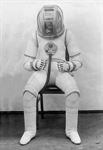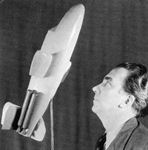Фотографии
-
Pilots of the Messerschmitt Me 163 Komet, which had entered operational service in May 1944, wore polyvinyl chloride (PVC) flight suits, as seen here. New suits were devised for the Natter pilots, however, which gave some protection against the propellants - but, more importantly, a higher degree of protection against fire, deemed a more serious threat.
Самолёты на фотографии: Messerschmitt Me.163 Komet - Германия - 1941
-
A pair of externally mounted Schmidding SG 34 booster rockets, one each side of the fuselage, are seen here being tested on an early Natter airframe that has been strapped to a wheeled cart in a shed at the Bachem factory. A rather crude curved metal shield has been fitted to the boosters’ aft ends to offer some protection for the wooden fuselage. Four jettisonable boosters were to be fitted to operational Natters.
Самолёты на фотографии: Bachem Ba.349 Natter - Германия - 1945
-
The HAS-16 high-altitude bale-out oxygen system was to be standard issue for operational Natter pilots, and comprised a parachute pack and oxygen mask supplied by ten miniaturised steel oxygen cylinders in a box, the latter as seen in the photograph to the right.
Самолёты на фотографии: Bachem Ba.349 Natter - Германия - 1945
-
Natter M52 (prototype examples were initially referred to as Baumuster - construction type - with a number, subsequently shortened to just M plus number) was used for unmanned trials with the Zundstangen-Lafette (ignition pole platform) - essentially a stripped-down tree trunk with rudimentary launch equipment attached - in April 1945. Note the yellow monitoring symbol on the wing.
Самолёты на фотографии: Bachem Ba.349 Natter - Германия - 1945
-
An unmanned Natter completes a vertical take-off (VTO) launch test, with the rear section of the fuselage and dummy pilot returning to earth via parachute. Leather dummies were used in most trials, and only one manned Natter flight was ever made, on March 1, 1945, by test pilot Lothar Sieber. It lasted less than a minute, and ended with Sieber losing his life.
Самолёты на фотографии: Bachem Ba.349 Natter - Германия - 1945
-
The Dragerwerk light pressure suit was far in advance of any contemporary Allied prototype suit, incorporating ball-bearing joints at the shoulders, hips and upper arms and articulated glove fingers. Flexibility at the elbows and knees was provided by tucked fabric joints which would not be used again until 1956 in the US Navy’s Goodrich Mk II suit.
Самолёты на фотографии: Bachem Ba.349 Natter - Германия - 1945
-
A Bachem technician tests the positioning of the pilot’s seat in an early mock-up of the Natter’s cockpit, mounted on a frame-and-pivot arrangement enabling the section to be tilted to various angles for trials.
Самолёты на фотографии: Bachem Ba.349 Natter - Германия - 1945
-
Erich Bachem examines a model of the Bachem-Werk Projekt 20 (BP-20), as the company referred to it before it was officially designated Ba 349.
Самолёты на фотографии: Bachem Ba.349 Natter - Германия - 1945
-
Commissioned by the author for his new definitive book on the Natter, this speculative painting by BARRY SPICER © 2019 (www.barryspicer.com) depicts a test pilot in pressure suit and helmet preparing to launch in the Ba 349B-0 (which never flew) from its test site at Heuberg in south-western Germany in 1945.
Самолёты на фотографии: Bachem Ba.349 Natter - Германия - 1945
-
This cutaway illustration shows the Natter’s interior configuration, with the pilot seated ahead of the propellant tanks, the uppermost of which contained T-Stoff, with the C-Stoff tank below it. The rocket motor was directly behind the tanks, with a thrust tube running aft to the combustion chamber at the rear of the fuselage.
Самолёты на фотографии: Bachem Ba.349 Natter - Германия - 1945
-
This artwork by GINO MARCOMINI shows Natter M23 on its steel tower before the launch of the type’s only manned flight, by Lothar Sieber on March 1, 1945. The aircraft completed a successful VTO before pitching backwards, at which point the canopy broke off and Sieber was probably knocked unconscious, the Natter arcing into the ground.
Самолёты на фотографии: Bachem Ba.349 Natter - Германия - 1945
-
This sketch by Bachem shows an early iteration of the definitive Natter concept, illustrating how the machine comprised three basic components: a nose section with armament; mid-section with cockpit (note crouching pilot with parachute) and two propellant tanks (T1 = T-Stoff, T2 = C-Stoff) and rear section with rocket motor and fuselage-recovery parachute (marked S).
Самолёты на фотографии: Bachem Ba.349 Natter - Германия - 1945
-
Sketches of three variations of pilot position considered by Bachem, left to right: prone, crouched and seated. The numbers mark the positions of the windows.
Самолёты на фотографии: Bachem Ba.349 Natter - Германия - 1945
-
Erich Bachem joined the Gerhard Fieseler Werke GmbH in 1933, and by 1941 was working in the company’s Advanced Projects Office, for which he designed the Fi 166 Type II “horse-and-rider” interceptor concept seen here, which incorporated a rocket for launching fitted to the underside of a twin-engined fighter design. Bachem left Fieseler to establish his own company in February 1942.
Самолёты на фотографии: Fieseler Fi.166 - Германия - 1941
Статьи
- -
- A.Griffith - Ploughshares into Swords
- B.Gooden - Absolute Beginners
- B.Livingstone - The Longest Hop (2)
- C.Gibson - What's French for Fait Accompli..?
- D.Hagedorn - Corsario Jr Legend
- D.Watson - The Highlands, Channel Islands and beyond...
- G.Alegi - From Furniture to Fighter
- K.Hayward - Airbus Industrie
- M.Russell - Bring Out the Big Guns
- P.Davidson - Off the Beaten Track...
- P.Jarrett - Lost & Found
- P.Le Blanc Smith - South by Southeast
- P.Lewis - Where Falcons Dare
- P.Marson - Howard Hughes & the Constellation
- T.Jupp - Everything Must Go













